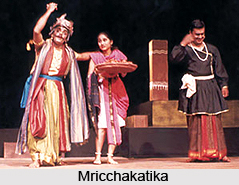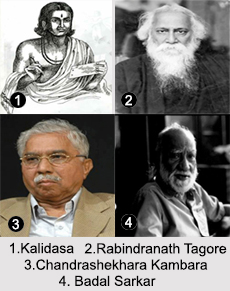 A number of dialects are introduced in the Sanskrit plays which enhanced the realistic nature of the plays. The dialects varied according to the social position of the different characters. The gods, most of the Brahmanas and princes spoke in pure Sanskrit language and female characters spoke Prakrit language. These minute variations of dialects contributed to the introduction of realism. Dramas where only pure Sanskrit is used such as Dutavakya or where only pure prakrita is used like Karpura-manjari are very rare.
A number of dialects are introduced in the Sanskrit plays which enhanced the realistic nature of the plays. The dialects varied according to the social position of the different characters. The gods, most of the Brahmanas and princes spoke in pure Sanskrit language and female characters spoke Prakrit language. These minute variations of dialects contributed to the introduction of realism. Dramas where only pure Sanskrit is used such as Dutavakya or where only pure prakrita is used like Karpura-manjari are very rare.
The dialect of a character appears to have been fixed by convention, and although in the Mricchakatika this rule is observed with fair rigidity, one cannot say that it is universal.
According to theorists, Sanskrit is the language of members of the higher castes such as kings, Brahmanas, learned men, ministers and generals. Occasionally the senior queen, female ascetics and members of the harem also converse in Sanskrit. Sanskrit should also be used when people speak on war and peace, on omens and similar subjects. Prakrita is spoken by women, children and men from the lower strata of society. Bharata lays down simple rules for the use of prakrita dialects in the Sanskrit plays. Bharata enumerates seven principal Prakrita dialects for use in dramas. They are Magadhi, Avantija, Pracya, Sauraseni, Ardha-magadhi, Balhika and Daksinatya.
The principal prakrita dialect used in the dramas was sauraseni, for both prose and verse. It could be used by anybody in the drama. It was famous as the popular dialect of the Doab of the Yamuna River and Ganga River. According to theorists, it is the language of the heroine, her friends and attendants and usually of women of good families. It is also spoken by ordinary men. The vidusaka and others spoke Pracya, which was hardly dissimilar to Sauraseni, while rogues employed Avantija. Ardhamagadhi was spoken by slaves, sons of kings and masters of guilds. The inmates of the royal harem, inn keepers and watchmen conversed in magadhi.
According to Bharata, daksinatya should be spoken by warriors, police officers and gamesters. Balhika is the native speech of the Khasas who belong to the north. In the use of sub dialects, sakari was assigned to the Sakara and the Sakas and other groups of the same nature, sabari was prescribed for those who lived in places where elephants, horses, goats, sheep, camels or cows were kept. The cowherds, out casters and foresters used their own forms of speech and even mischievous imps had their suitable language.




